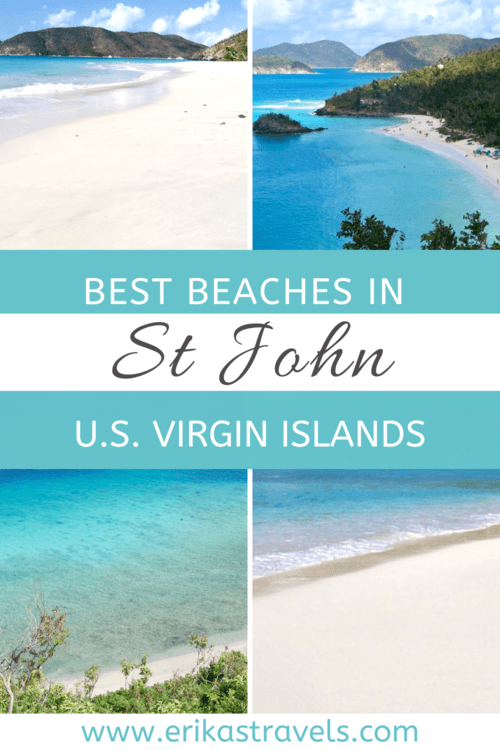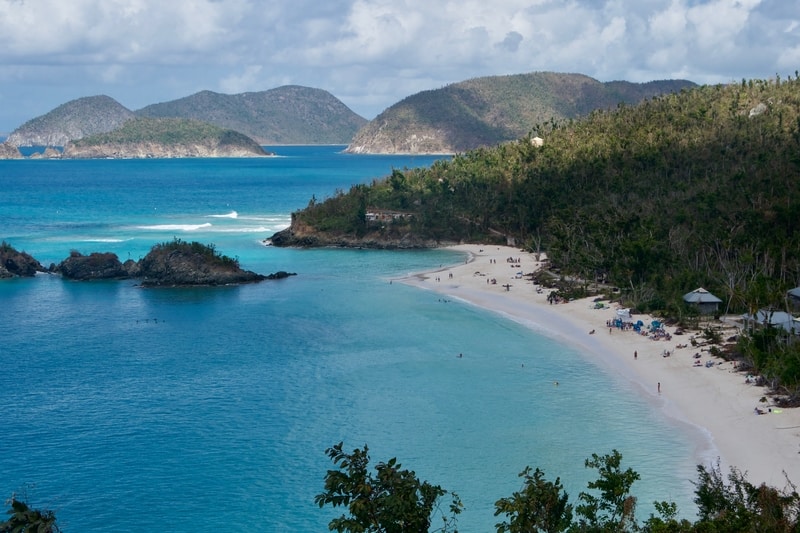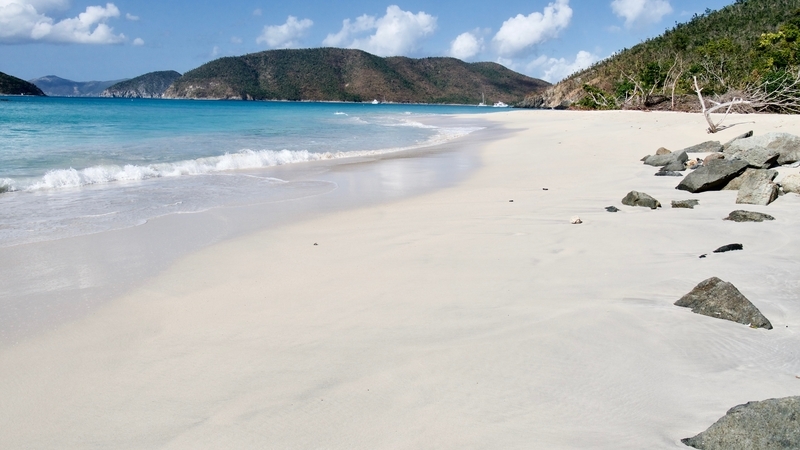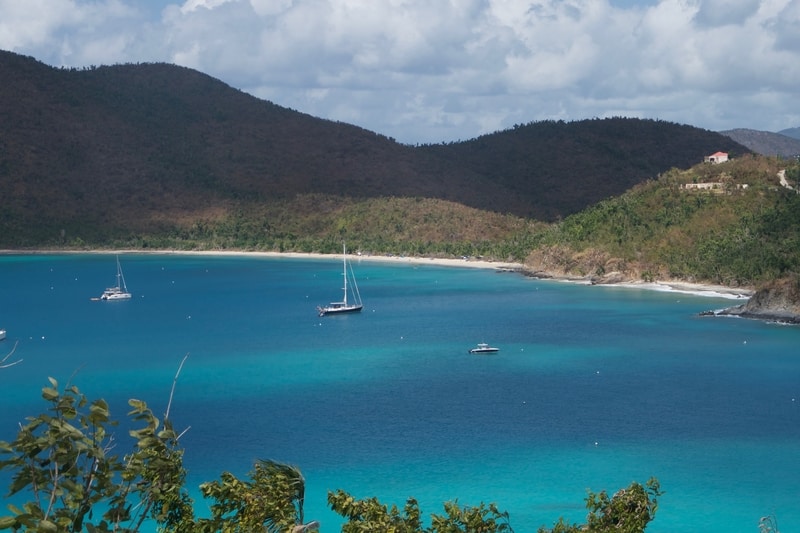
The Best Beaches in St John, USVI
The tiny Caribbean island of St John is home to untouched wilderness and pristine landscapes. It is a fleck of emerald in a sapphire sea. A place where nature still rules supreme. With its blanket of greenery, its idyllic beaches, and its translucent waters, the small territory is the most scenically endowed of the three main U.S. Virgin Islands (USVI).
St John wears a thick green cloak of gnarled trees and spiky cacti. These forested hillsides—part of a US Virgin Islands National Park—cover two thirds of the island’s surface.
Beyond its verdant interior, a series of crescent beaches lie strung about the island’s outer fringes. These sun-kissed St John beaches boast soft powdered sand and warm turquoise waters.
They are among the most beautiful in the Caribbean.
U.S. VIRGIN ISLANDS NATIONAL PARK
When visiting the National Park of the USVI, hiking and beach-lounging top most to-do lists. Trails wind by petroglyphs and sugar-mill ruins. Several lead to pristine beaches prime for swimming, snorkeling and soaking in the warm rays of the Caribbean sun.
In 1956, Laurance Rockefeller donated much of the land on St John to the U.S. National Park Service, under the condition that the land would remain protected from future development. As a result, the shuttered Caneel Bay Resort—a popular accommodation that was ravaged by the hurricanes—is one of the only structures within the confines of the park. It operates on a lease arrangement with the National Park Service.
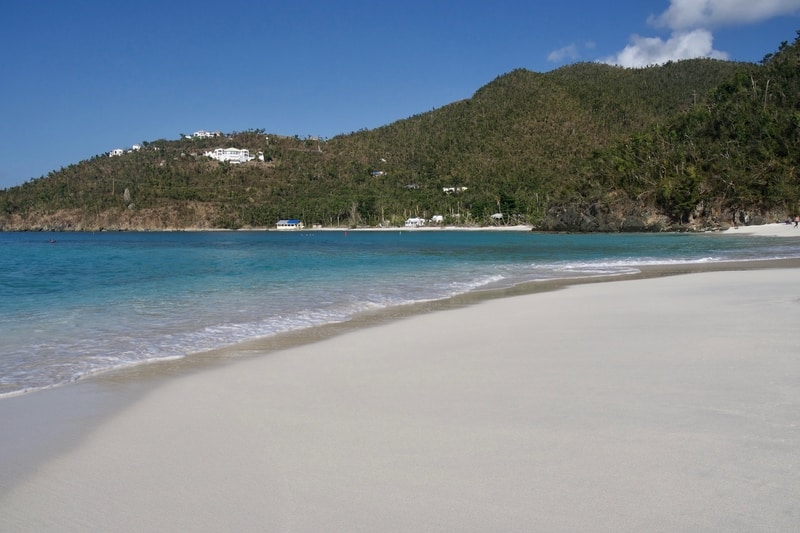
The USVI National Park Visitor’s Center lies in Cruz Bay, approximately two blocks from the ferry dock. The center holds informational placards and displays, distributes maps of the park’s beaches, and provides tourists with information on the top things to do in St John.
DISCOVERING THE BEST ST JOHN BEACHES
I traveled to St John to volunteer with All Hands and Hearts, in an effort to help the island with its recovery in the aftermath of Hurricanes Irma and Maria.
Though I visited the island primarily in order to assist with its rebuilding, I rewarded my long hours of physical work with afternoons at some of St John’s best beaches.
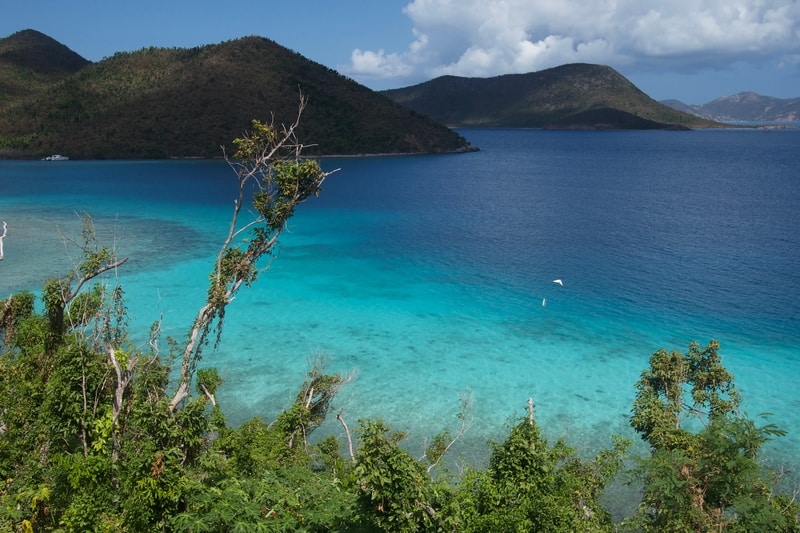
Each day, after mucking and gutting damaged houses for eight hours, my volunteer group and I would descend upon the island’s crescent shores for a refreshing dip in the sea.
Many of the most beautiful beaches in St John lie within the confines of the U.S. Virgin Islands National Park. They include Trunk Bay Beach, Cinnamon Bay Beach, and Hawksnest Bay.
-
TRUNK BAY BEACH
Trunk Bay Beach is the most famous beach in St John. Over a quarter mile of brilliant white sand makes it the island’s showpiece attraction.
Trunk Bay’s clear waters and silky coral sands draw tourists in droves. The beach’s well-maintained facilities include chair rentals and showers.
While I found it to be crowded compared to the other beaches in St John, there is no doubt that Trunk Beach is special. Its crescent bay is worthy of postcards and a feature in Caribbean travel brochures. It is comparable to places like Shoal Bay Beach in Anguilla and Seven Mile Beach in Jamaica.
Trunk Bay Beach is considered the one of the finest beaches in the Caribbean. Yet, while its blissful shores are welcoming and inviting, the beach’s idyllic setting is what makes it truly unforgettable.
From the road that traverses the island’s national park, views of the brilliant white sand and its surrounding greenery are drop-dead gorgeous.
-
CINNAMON BAY BEACH
While Trunk Bay Beach is the island’s standout, Cinnamon Beach doesn’t fall far behind.
The beach lies within the USVI National Park, sandwiched between Trunk Bay and Maho Bay. It is the largest beach on St John and, without a doubt, one of its best.
Mile-long Cinnamon Bay is a stunning stretch of sand. When I traveled to Cinnamon Beach in 2018, however, the area was still visibly devastated from the 2017 twin hurricanes that ripped through the area. Cinnamon Bay’s archaeological museum, campground, restaurant and water-sports facilities were all largely closed and roped off.
Prior to the hurricanes, Cinnamon Bay contained a resort and campground. These tourist accommodations suffered extensive damage from the storms.
As of now, they have yet to fully recover. The aim is to restore the area to its former glory by 2021.
-
MAHO BEACH
Maho Bay Beach is a favorite among tourists and locals alike. The long and narrow beach sits adjacent to the North Shore Road.
Not only does Maho Beach contain beautiful white sand, but its convenience just off the roadside makes it the perfect St John beach for families and and those with limited mobility.
Maho Bay is purported to have some of the best snorkeling on St John. Tall sea grass—a magnet for green sea turtles—blankets the sandy floor of the bay.
Unfortunately, I failed to spot any marine animals when I visited the area for a brief afternoon snorkel.
-
HAWKSNEST BEACH
Hawknest Beach, another scenic stretch of sand in the USVI National Park, has gorgeous clear water and a pretty shoreline. It lies sandwiched between Caneel Bay and Honeymoon Bay, just a few minutes away from the St John ferry dock.
Hawksnest’s proximity to the town of Cruz Bay makes it a popular spot. But in no way did I feel the beach was overrun.
In fact, I found Hawksnest Beach to be relatively quiet when I visited.
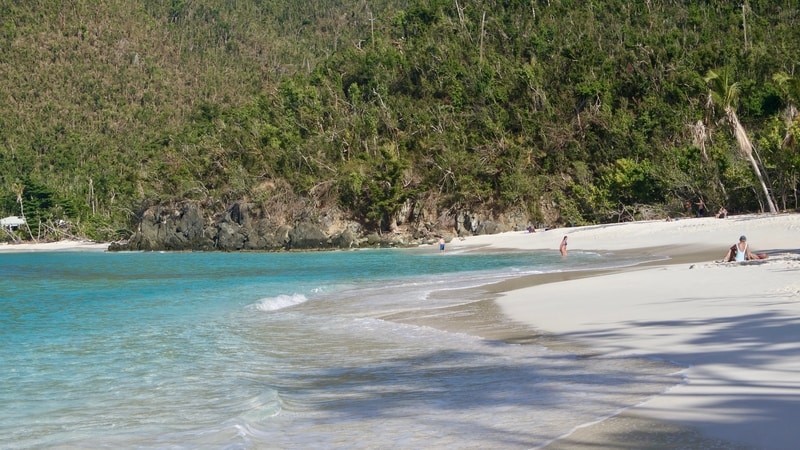
Situated within a concealed bay, it has a more intimate setting than some of the island’s other stretches of sand. Its powdery shores contain plenty of shaded areas.
-
HONEYMOON BEACH
Honeymoon Beach is smaller and less crowded than the other top beaches in St John. Located adjacent to the Caneel Bay Resort, it consists of a small crescent of sand and crystalline waters.
I can only surmise that the lack of crowds I encountered at Honeymoon Beach was, in large part, due to the fact that I visited while the adjacent resort remained closed.
The Lind Point trail connects Honeymoon Beach with the Virgin Islands National Park Visitor Center in Cruz Bay. It is a lovely path that passes by Salomon Beach and reveals panoramas of Cruz Bay from above.
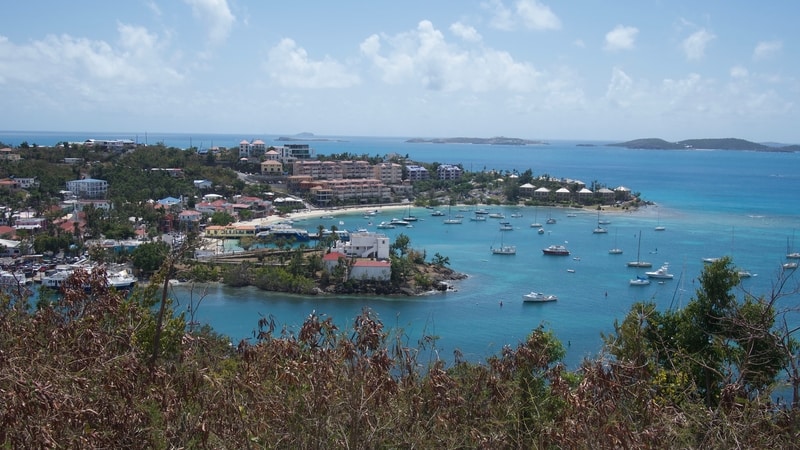
At night, the waters of Honeymoon Beach sparkle with bioluminescence. Millions of plankton puncture the darkness with their luminous glow. It is otherworldly. Enchanting.
Due to its proximity to our volunteer lodging, I visited Honeymoon Beach nearly every evening during my stay on St John. And each night, without fail, bioluminescent plankton illuminated the night—littering the waters with millions of tiny pinpricks of light.
-
LEINSTER BAY AND WATERLEMON CAY
Leinster Bay lies just north of Coral Bay, on the eastern side of St John Island. The bay connects to the Annaberg mill ruins via a narrow path. Some of St John’s best snorkeling can be found at Leinster Bay’s east end, near Waterlemon Cay.
The walk from the sugar mill ruins to the beach takes about 25 minutes.
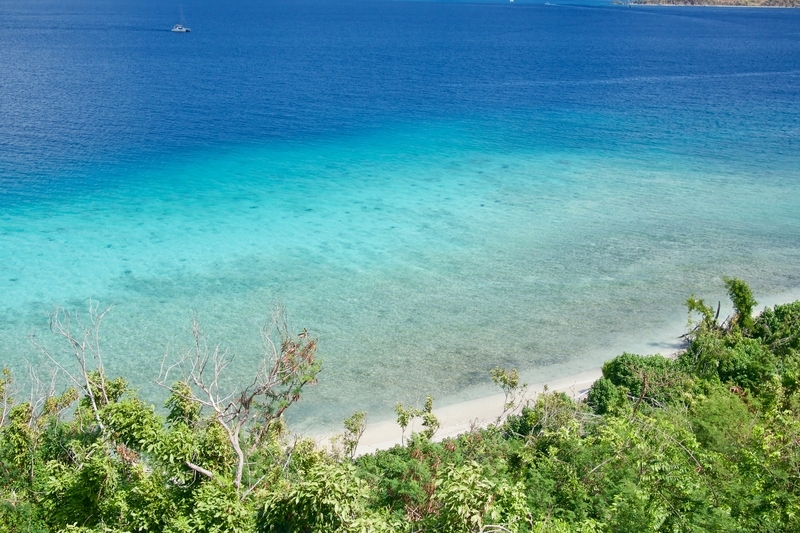
Before heading down to the small beach areas of Leinster Bay, it is worth checking out the ruins of the sugar plantation. This small historical attraction features the most intact plantation ruins in the U.S. Virgin Islands. A 30-minute self-directed walking tour leads through the site’s slave quarters, towers, and dungeon.
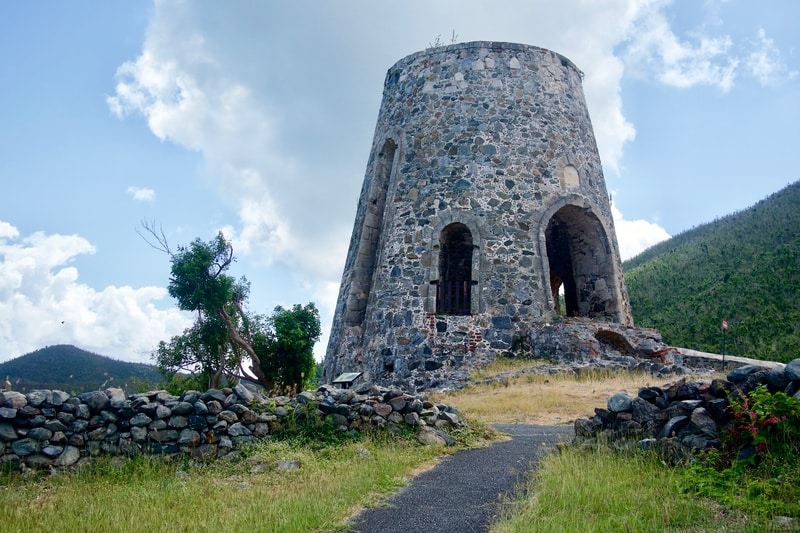
Like Maho Beach, Leinster Bay contains tall sea grasses that attract turtles, spotted eagle rays, barracudas and nurse sharks. Though the reef was still partially destroyed by the hurricane during my visit, I was nonetheless able admire the colorful coral and schools of fish that adorn St John’s premier underwater paradise.
WHERE TO STAY IN THE USVI
St John is small enough that you can encircle the island in a matter of hours. Its two main settlements are located on opposite ends of the island—in Cruz Bay and Coral Bay.
Cruz Bay is the larger and more vibrant of the two towns. It is home to the ferry dock, rental car companies and the national park visitor center. Many tourists choose to stay in Cruz Bay due to its plentiful food and lodging options. Coral Bay may appeal to those looking to stay in the heart of the USVI National Park.
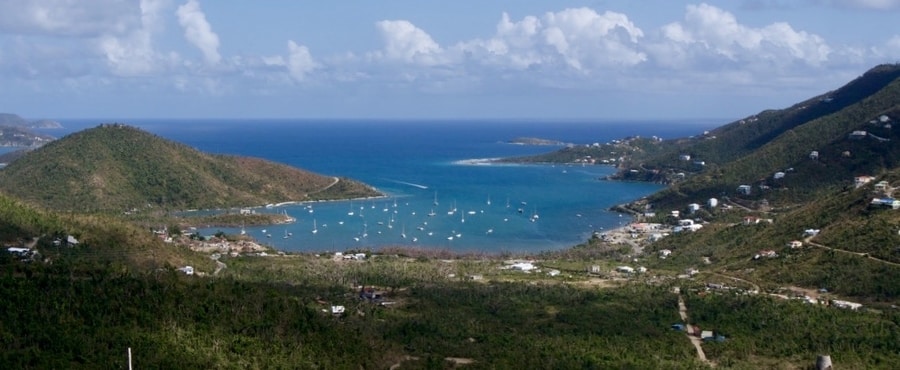
Top-rated accommodation options in St John include the Gallows Point Resort (Cruz Bay), the Calichi at Picture Point (Coral Bay) and the Concorida Eco-Resort (at the island’s easternmost tip).
WHEN TO VISIT THE USVI
During the the USVI’s peak season, from December to March, pleasant temperatures hover around 80 degrees during the day. Winter holidays, however, mean that resorts and hotels adjust their rates to profit on high demand.
The best time to visit the U.S. Virgin Islands is from April to June. During the springtime, visitors can expect mild weather, little rainfall, and thinner crowds.
Summer months mean lower rates on accommodation. But be aware that from July-November, visiting the USVI comes with the risk of heavy rains and hurricanes.
***
St John may be part of the United States, but its Caribbean location blesses it with tropical beauty and island charm. The idyllic fleck of land showcases landscapes comparable to those of St Lucia and Saba, and beaches that rival some of the most beautiful in the Caribbean.
I could tell St John was special from the moment I set foot on its soil. There are no airports or cruise docks on the island. Instead of eyesore resorts and manicured lawns, leafy trees caress the island’s shores. The small US territory is a bastion of authenticity in a region that often favors multinational hotel chains and luxury resorts. It is intimate, idyllic, and dripping in beauty.
St John is blissfully low-key and crowd-free.
Both travelers and locals would like to keep it that way.
_______________________________
Did You Enjoy this Post on the Best St John Beaches? Pin It!
